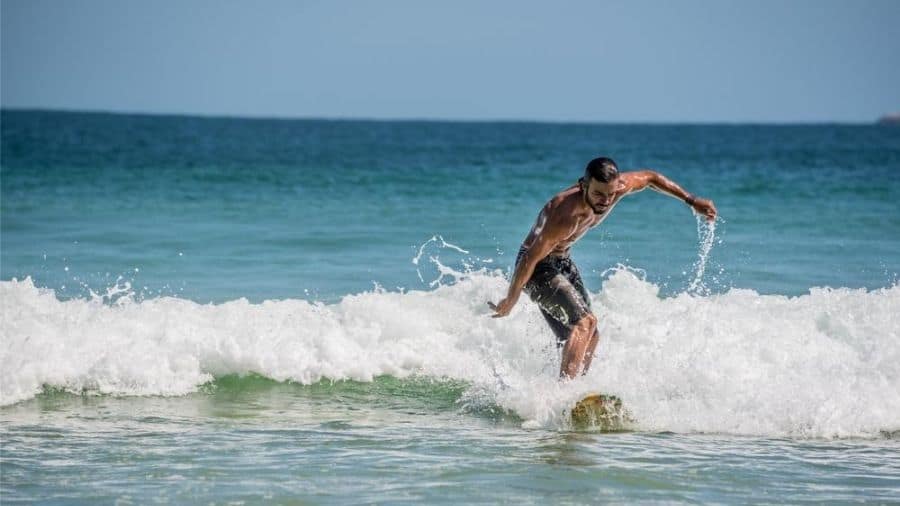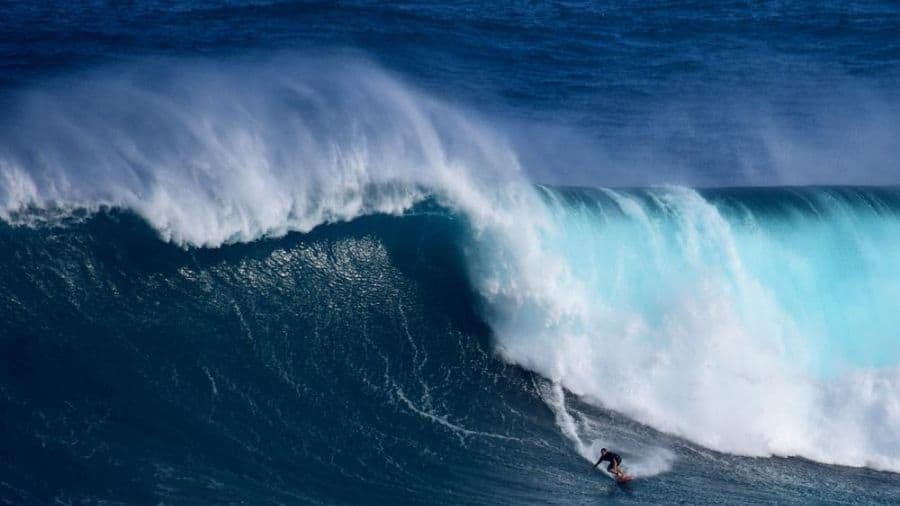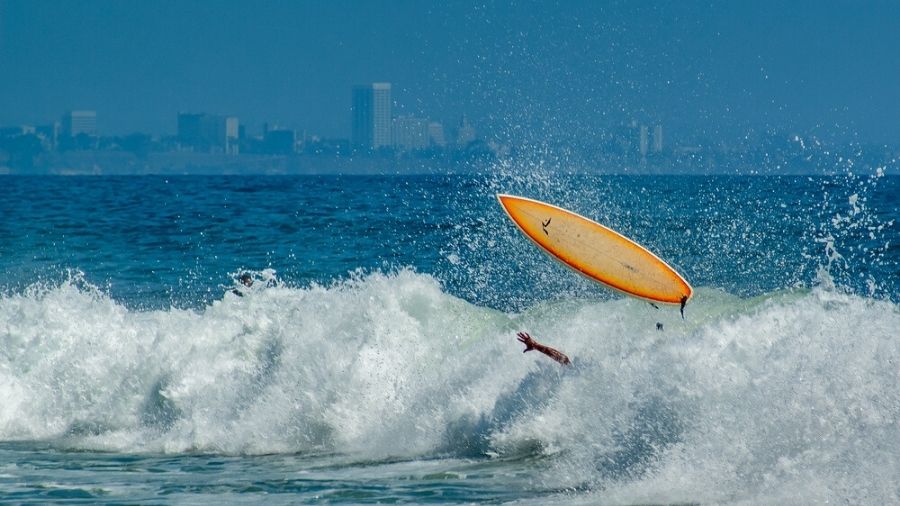
Learning how to surf can be the most rewarding experience of one’s life. Entering the endless romance of surfing does come with its risks. Most surfers have paid in blood for the privilege of riding the untamed stallions we call waves. Is surfing worth the risks and dangers that come along with learning?
Surfing is not dangerous for beginners. As with all sports, there is an element of risk, but with a few precautions, most dangers easily are avoided. Avoiding big waves and collisions with your own board, wearing sun protection, and knowing how to fall properly are some of the ways to surf safely.
Surfing does have dangers and most will acquire some sort of minor injuries along the way, but that shouldn’t deter anyone from learning. I’ve made a list of the most common dangers for a beginner surfer and how to avoid them.
Table of Contents
1. Big waves
Big surf is dangerous for learners. What eventually you’ll want all the time, big waves will be scary and new in the beginning.
Big waves are dangerous because they are very powerful and will hold you underwater longer. For a beginner who isn’t used to being held under very long, this is quite dangerous because they could panic and swallow water. And if there are many big waves in a row it can and will exhaust the poor little guy just trying to get back to the safety of the beach.
A beginner should ease their way into surfing, riding bigger waves as they get better and more comfortable.
An easy way to do this is to check the surf report. The most common one being surfline. You can check and see how large the waves are going to be the same day you’re going out, or for future dates as well.
Once waves start getting over the 4-foot mark that’s getting a little big for newbies. Surfline will tell you other excellent information as well like how long the swell period is so you’ll know when it gets smaller, along with other useful information about tides and water temperature. There’s even webcams so you can see the waves with your own eyes.
Speaking of looking at waves with your own eyes, check the waves before you go out. Don’t just paddle out without giving it a second thought. Wait at least to watch one set. You could get to the beach, look at the waves and think oh wow it’s small today, but you didn’t actually wait around to watch a set come through and it’s actually massive. This is probably how the majority of beginner surfers get themselves in trouble with big waves.

2. Collisions With your own Surfboard
Getting hit with a board is never pleasant. And to add insult to injury it’s even worse when it’s your own.
There are a few common ways this can happen. This mainly happens while going back out through the waves after riding a wave in. A lot of beginners like to pick their boards up over waves which is perfectly fine and normal.
The problem arises when they hold their boards sideways or perpendicular to the waves. Picture a roman soldier holding up a shield up to an enemy. So the wave hits the board. Hard. then in turn the board hits said beginner. Hard. and possible injury follows.
Or the beginner has just finished a ride and their board is floating in between them and another oncoming wave. The next waves picks up the board and throws it into the beginning surfer. These problems are easily fixed by holding your board straight and always being aware of where your board is at all times. Make sure your board is never in between you and a wave.
This is why soft top foam boards are so common for learning. Fiberglass or epoxy is very hard and a hit to the head or shin can easily require stitches. So many beginners choose to use a foam board, so if they get hit while learning they’ll only have to endure some minor bruising. Then once they have progressed a bit, and have learned how to avoid their own board they upgrade to epoxy or fiberglass.

3. Riptides
Riptides or rip currents can affect surfers and swimmers alike. A riptide is a narrow powerful current of water running perpendicular to the beach, flowing out into the sea. A riptide may be as long as 2500 feet but are generally only about 30 feet wide.
There are a number of reasons why rip currents form, but the most common is break in sand bars. Sandbars are hills of sand formed by waves. Sometimes they can be quite large. When there is a break in a sandbar all the water it was blocking starts flowing out to sea. You can think of it like pulling the plug in the bathtub.
Rip currents are so dangerous because they catch people off guard and of course they fight for their life trying to swim back to shore. But that is a hard won fight.
They can be so strong there’s no way you’re getting back to shore on the old water treadmill. So you have two options…
Like we said above rip currents can be long but not very wide. So instead of wasting your energy trying to swim back to shore, just swim to the side parallel to the beach in either direction. Once you’re out the ocean river swim back to shore.
Option two give up. Let it take you out to sea and just relax and enjoy the ride. It will pull you out further yes but then it will shoot you out to the side a bit and you can have a long, relaxing uninterrupted swim back to shore.
Riptides are easier for surfers to handle because you do have a nice floating life preserver hopefully attached to your ankle in the form of your surfboard. And paddling on a surfboard will always be faster than swimming, but still use caution.
4. Collisions with other surfers.
This is a big one. You can not only injure yourself but other people as well. And also jack some boards up in the process. Collisions happen when two surfers run into each other, either on a wave or in the process of going in or out of the surf.
The main way collisions happen on waves is not looking. Or for lack of better words not looking both ways before one crosses the street to shred.
So accidently dropping in on people can cause them. That’s when someone is already riding a wave and another person drops in anyway. So what will happen is a beginner doesn’t look to see if someone is up and riding, drops any way, right in front of the persson already riding the wave and they collide.
This can be dangerous for both parties involved, especially if both riders are using hard epoxy or fiberglass boards. Boards or even worse the fins on the boards can cause cuts and or bruising that isn’t very pleasant.
Another very common collision is when a new surfer is paddling back out to the line up through the surf. These collisions are especially common on crowded days.
So imagine the newbie paddling out to sea away from the beach. There is someone up and riding on a wave that could break on the newbie. Now what the beginner should do is paddle behind the surfer who is already riding even if that means taking the wave on the head. But what happens more often than not is that the beginner tries to paddle in front of the rider in fear that the wave will land on them. This is most dangerous for the beginner paddling because they are essentially getting ran over.
5. Sunburns
This may seem silly but its one of the more serious topics on this list. Sunburns are very dangerous, especially in the long run and should not be taken lightly.
It is possible to get 3rd-degree burns from the sun without proper application and the proper SPF.
There are many different sunscreens surfers use but zinc seems to be one of the most popular. In extremely sunny surf spots close to the equator such as Indonesia, many surfers go full whiteface, where you completely cover your face with zinc for full protection. Though many opt for just the nose and under the eyes. Nowadays zinc even comes in many fun colors such as pink, blue, green and red.
To protect the body lots of people wear a shirt while surfing in warm water or a rash guard. In cold water, you’ll most likely be wearing a wetsuit so won’t have to worry about it.
You can also lather your whole body in sunscreen although that might raise your monthly screen costs substantially.
Even on overcast days, sunscreen is highly recommended. You can still get a gnarly burn even when the sun isn’t shining. Sunburns are so bad for surfers because not only are they getting a direct hit from the sun, the water is reflecting the sun back at them as well. Double trouble bubble wubble.
A beginner surfer may not wear sunscreen and not think anything of it. But long down the line, when they haven’t been a beginner for years those beginner mistakes will strike in the form of skin cancer. Skin cancer can cut a surfing career short for obvious reasons. And in the best-case scenario you’ll get a skin graft from your butt to your nose becoming a literal butt face, just like my great grandma Da.
6. Fall Flat, Covering the Head
Falling is an inevitable part of surfing. It will happen whether you’re a beginner or a seasoned pro. But when you are learning there are some certain ways you can fall to keep yourself safer.
In the very beginning of your surfing journey, you’ll more than likely be surfing the whitewash. That is the white foamy part of a wave that forms after the wave has broken. This part of the wave is great for practicing ones pop up and getting your sea legs.
The thing is these whitewash for the most part break in shallow water. So when beginners fall they can be falling into really shallow sand or rocks depending on the beach.
So they either fall on their feet in shallow water and possibly sprain an ankle or knee. Or for some reason do the opposite, dive-bomb straight to their head, causing neck and or cranium injuries.
An easy way to combat this is to fall flat. So either back flop or belly flop in a sense. Like a pancake into the pan of shallow water. This will help prevent you from hitting the bottom and acquiring any preventable injuries.
As a beginner, you will pearl a lot. Pearling is when the nose of your board goes underwater. Also commonly referred to as nose-diving.
This can cause the boards to fly up in the air after a nosedive. Surfboards are very buoyant so after being shoved underwater during a nose dive they tend to spring back up out of the water and into the air. The main danger this can cause is boards landing on people’s heads.
That is why it is very important after a fall, especially a nose dive to cover your head with both hands. It’s better to take a board on the arms or hands then the face or head.
7.Reefs / Rocky Bottoms
Waves form and break when an ocean or wind swell comes in contact with a shallow surface. This surface can either be the land like the beach or reefs made of coral or rock.
What causes a wave to break will be what is under you while you are riding. so if a wave is breaking off a coral reef, sharp coral will be on the bottom waiting for you when you fall.
Beginners are just learning so this means they fall much more, it’s part of the learning process. That is why many beginners choose to learn at beach breaks.
A beach break is just like its name suggests, waves breaking on the beach. As many beaches are sand this makes a great learning environment with a soft sandy bottom. So if a beginner does get unlucky and ouch bottom on a fall they only hit the friendly sand bellow.
Reef brakes on the hand are waves breaking on either a coral or rock reef. This is not the most ideal for beginners because if they fall and touch bottom they’ll be in for a potentially rocky surprise or worse, coral. This can cause some pretty serious cuts that could result in stitches or worse.
So as a beginner it’s a good choice to choose a beach to learn at with a sandy bottom. The potential of getting hurt is lower and there are other beginners there as well.
Many surfy areas like California have beaches that are known for learning and beginners. If you are going to surf a reef or point break make sure it’s not very shallow or an advanced break.
8. Marine life
When surfing you’re entering the unspoken bond of Atlantis, as old as time. Stepping into a world of wonder, beauty and life. A Lot of life. You will see lots of amazing marine life while surfing. From dolphins and whales to tropical fish and corals. 99 % of the time you bask in the glory and beauty we call nature, but there are a few creatures in the deep dark sea that can pose a threat.
The number one big dog most of y’all are probably thinking of, the king of the water jungle, good ol Mr Shark. Are sharks a serious threat to surfers? I would say no. Do surfers still get attacked by sharks? Yes. The numbers are small, and there is statistically a low chance but it does happen.
There are places that have more sharks than others. The top shark hotspots being Australia, South Africa, and the States. The majority of attacks happen in these places.
So what can you do to prevent becoming shark bait? Well for one you can not surf. Ok but seriously? Make sure to check local reports of shark sightings.
Just like waves, in certain areas there are shark reports as well, informing people on how sharky the waters are. Many people wear a wetsuit with a thick white band painted around the thigh. This deters sharks because it breaks up the surfer, making them look less like a seal or turtle from below.
Other marine life to be worried about are stingrays and jellyfish.
Stingrays can leave quite a painful punch on the bottom of the foot if stepped on, so make sure if you are at a ray heavy beach to shuffle your feet while walking to scare off any of the little guys.
Jellys can leave a painful sting as well, and some, like the box jelly from Australia, are even fatal. So just keep an eye out for any floating jellies and try to stay clear.
For the most part, marine life is a beautiful added bonus of surfing and does not cause much of a threat.
9. Locals
Unless you’re extremely lucky you will have to learn to surf around others. Part of this learning process is learning the proper etiquette for the line-up.
The line up is where everyone sits waiting for waves. There is a process of catching waves and taking turns without getting in people’s way. As beginners are still learning this process, sometimes they can get in the wrong locals’ way and that can cause some issues.
I’ve seen too many times some salty old local tear the head off some unlucky beginner. Many beginners can go out and not even know that there is a certain etiquette in the water to be followed and this can cause trouble with the locals.
So even if it’s a beginner wave, locals still surf there because it’s fun and probably close to their house. Oftentimes many beginners come from far and wide to practice in the gentle forgiving surf.
Many beginners only go straight, so if there is more than one learner on a wave that is fine because everyone can just go straight together. This becomes a problem when an experienced local gets on the wave.
A learner will go straight right in front of them blatantly cutting them off. This egregious move will anger the local and depending on the person, words or blows could be exchanged.
It’s very important for beginners to learn proper etiquette out in the water and treat locals with respect. It is rare in this day and age that things get violent but it’s still better to be on the safe side.
10. Leash Tangle
The leash. The old foot string. The leg rope. The leash is a urethane cord that connects from the back of your surfboard to the rear ankle with a padded velcro strap.
It prevents your surfboard from getting away from you after a wipeout. In most cases, it is very useful ensuring you don’t have to go for a long swim after your board. It also ensures your board doesn’t run into any people or things injuring them or the board itself.
But sometimes if the leash is in a weird position it can get tangled around a body part causing more harm than good.
If it gets wrapped around your neck or an arm then your board is swept off in a wave the pulling force of the wave can be quite painful. Choking or dislocated limbs can happen. So how do you stop your leash from going full Mr.Grey on you?
One thing you can do is make sure the leash is pointing outward after you’ve connected it to your ankle.
So instead of having the leash coming out of the velcro ankle strap on the inside of your ankle, make sure it’s on the outside for a smaller chance of tangles.
Another option is purchasing leashes with swiveling connections. They will have 360 degrees rotation where they connect to the board and ankle strap. Meaning they won’t get tangled about as they can always swivel to freedom.
11. Polluted water
There are many beaches in this world near big cities or in big cities for that matter. Sadly pollution is something surfing has to worry about from time to time.
The state of the water depending on your location can be so horrific at times it is dangerous for your health. Causing disease, infection or illness. It’s very important to remember to check water quality levels online before going out for a surf in very populated areas. You want to ensure the water is safe to surf in and clean for your health.
It is also crucial to remember not to surf after rain. Especially heavy rain. As Dory says “all drains lead to the ocean“. That’s true. So in a big city near the beach, like Los Angeles, after a big rain, all the gross accumulated in the city has just been washed into the ocean.
The water quality levels will be very poor and it is not advised to go in the ocean for a couple of days. The problem is if there’s a nice juicy swell many people ignore this suggestion and take their chances in hopes of being rewarded with some tasty waves. I don’t blame them, I’ve done the same myself. But remember you are taking a chance.
If you have any open wounds or cuts it is extremely ill-advised as the chance of infection will skyrocket.
12. Surfing Alone

Awww surfing alone. A blessing and a curse. Of course, everyone wants to surf alone if they have the chance. Not having to share any waves or worry you’re dropping in on anyone is great. But it can be dangerous…
For the most part, this isn’t something many beginners have to worry about. Most surf spots, especially the popular beginners are fairly crowded and even have lifeguards more often than not. So you can rock up to the beach alone and not have to worry about surfing with a buddy or anything because another surfer or the lifeguard will help you out in the chance that anything goes wrong.
If you are going somewhere remote to surf then always bring a friend. It’s fun surfing empty beaches with your buddy and there will be more than enough waves to go around for the two of you. And if anything does go wrong, you have each other’s backs. If you are alone a minor accident could turn fatal with no one around to call for help, which would suck a lot.
